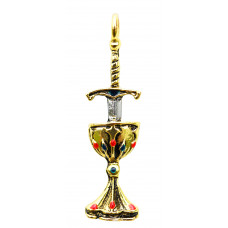Exkl moms: 76 SEK
Hängsmycket Blade and Chalice for Perfect Love and Perfect Trust är tillverkat av nickel- och blyfritt tenn, och dekorerat med guldplätering och emalj. Smycket är ca 13 mm brett och 38 mm högt, och till det hör en ca 44 cm lång halskedja av allergivänligt rostfritt stål.
Smycket Blade and Chalice ingår i smyckeserien "Talismans of the Knights Templar", och du får ditt smycke levererat i en svart smyckeask som har smyckets namn och betydelse förklarat på engelska på insidan av locket.
"På medeltiden trodde man att Tempelriddarorden vaktade den Heliga Graal med sina svärd. Den oövervinnerliga och fulländade föreningen av svärdet och bägaren skulle tillsammans bilda Kung Salomos Sigill och representera perfekt balans och fullkomlighet, och därigenom ge sin bärare Perfekt Kärlek och Perfekt Tillit."
"Tempelriddarorden vann ära och ryktbarhet under medeltiden och strävade efter att leva enligt den tidens högsta principer; Mod och Ridderlighet. Dessa krigare var vetgiriga och hade kunskap om många religioner, inklusive de hedniska och även magi. De var kända för både andlig och världslig rikedom, och myterna om dem är kända än i dag.
Tempelriddarna hade som uppgift att försvara kristna pilgrimmer i det heliga landet under korstågen, och de var disciplinerade, intelligenta och effektiva krigare. De var kända för sina rustningar och vita, symboliserande renhet, mantlar med röda kors.
Eftersom Tempelriddarorden stöddes av den katolska kyrkan fick riddarna snabbt omfattande privilegier och stor makt, och deras antal växte i Europa. De hade imponerande egendomar och var rådgivare till de rika och mäktiga. Stödet till dem minskade dock markant efter korstågen när de kristna förlorade det heliga landet.
Rykten spreds om Tempelriddarnas snabba väg till välstånd, att de erhållit sin makt och rikedom genom att använda kraftfulla, magiska reliker för svart magi och avgudadyrkan. Den franske kungen Filip IV var ivrig att få beslagta riddarnas rikedomar och pressade påven Clement V att upplösa ordern. Riddarna förföljdes och fänglades, anklagade för brott som kätteri och avgudadyrkan, och torterades till falska erkännanden som gjorde att kungen kunde beslagta deras tillgångar.
Många riddare tog tillbaka sina erkännanden men blev ändå avrättade för sina påstådda brott, lämnandes kvar mysterier och legender om detta hemlighetsfulla ordenssällskap som lever kvar än i våra dagar."







